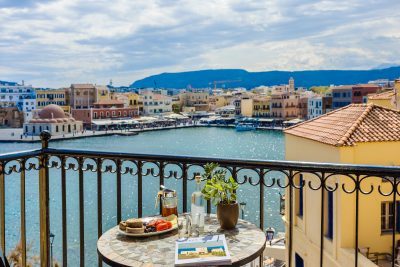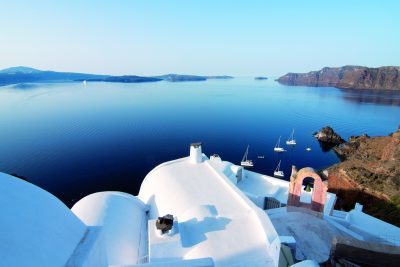Kefalonia
Argostoli
On a peninsula on Kefalonia’s southwest coast is the capital city of Argostóli. Although its history predates the 1950s, the old town was almost completely obliterated in an earthquake in 1953 and was rebuilt in modern style, following the original town plan. As a result, today it is a picturesque place, with a palm-lined seafront promenade, where local fishing boats moor up.
Fiskardo
Unquestionably Kefalonia’s prettiest village, Fiskardo lies on the northeastern tip of the island and is the only settlement to have retained its 18th-century Venetian-style architecture from before the earthquake. Backed by a dense cypress glade and built around a sheltered bay, it is popular with sailing crews who moor up their yachts here on summer nights. Most of the houses around the harbor now host upmarket seafood eateries, cafés, and holiday homes.
Assos
Assos is a peaceful little village on the island’s northwest coast, 10-kilometers from the popular village of Fiskardo. It is built on a causeway linking a hilly peninsula to the mainland. To reach it, you drive down a series of hairpin bends to where the village nestles in a quaint harbor, rimmed by seafood taverns. The peninsula is capped by the ruins of a 16th-century Venetian castle, which you can walk up to for a closer look (allow about 40 minutes), and there are a couple of pebble beaches close to the village, where you can swim.
Lighthouse of Saint Theodoroi
The lighthouse of Saint Theodoroi stands on a peninsula about 3 km north of Argostoli. The lighthouse was constructed in 1828 by the British, who ruled the island at that time. This is a structural building of Doric architecture, and its focal plane is 11m.
Agios Gerasimos Monastery
The Monastery of Agios Gerasimos is located on a mountainside close to Valsamata village, in the center of the island. This is where the protector saint of the island lived as a monk and where his relics are kept. People believe that their saint has miraculous skills.
Monastery of Kipoureon
The monastery of Kipoureon has been built on the edge of a steep slope and gives a gorgeous view of the sea and the sunset. It has many rare post-Byzantine icons.
Castle of Saint George
The Castle of Saint George stands on a hill above Peratata village, about 7 km from Argostoli. It was originally built by the Byzantines but the Venetians gave it its final form in 1504. The Castle is almost ruined today by invasions and the severe earthquake that hit Kefalonia in 1953.
Lixouri
Lixouri is the second largest village of Kefalonia, located 35 km west of Argostoli. The town lies around the blue bay of Argostoli overlooking the capital. Regular ferries connect the two destinations. The beautiful town of Lixouri was built on the site where the ancient city of Pali used to be, one of the four principal cities of Kefalonia during Antiquity. Due to the major earthquake of 1953 the city was destroyed and only a couple of mansions survived and can still be seen today.
The Potistis Waterfalls
The hike to Kefalonia’s waterfalls shows us an exceptional facet of the varied island’s landscape. Here nature holds a surprise that is hidden in the lush vegetation between Skala and Poros. In this region, you can find the Potistis waterfalls. Following the narrow path along a small river, this hike leads you through untouched nature to a variety of impressive smaller and larger waterfalls.
























